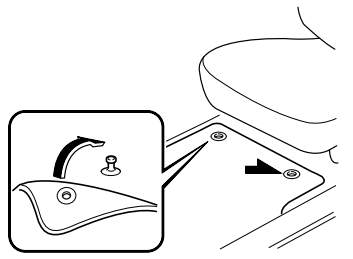Mazda CX-3: Seats / Front Seat
- Adjusting the Driver's Seat
- Driving Position Memory (Some models)
- Adjusting the Front Passenger's Seat
 Seat Precautions
Seat Precautions
WARNING
Make sure the adjustable components of a seat are locked in place:
Adjustable seats and seatbacks that are not securely locked are dangerous. In a
sudden stop or collision, the seat or seatback could move, causing injury...
 Adjusting the Driver's Seat
Adjusting the Driver's Seat
Using the driving position set up procedure recommended by Mazda allows you
to maintain a relaxed posture, drive the vehicle for longer periods without
feeling tired, and make quick operations naturally...
Other information:
Mazda CX-3 (2015-2025) Owner's Manual: Center Console
The rear divider can be removed and stored. Removing the divider provides a console box with a wider space. Pull out the divider. Insert the divider into the armrest from the top with the flap side of the divider facing the underside of the armrest, and press it in until a click sound is heard...
Mazda CX-3 (2015-2025) Owner's Manual: Advanced Smart City Brake Support (Advanced SCBS)(Some models)
The Advanced SCBS alerts the driver of a possible collision using the display and a warning sound when the Forward Sensing Camera (FSC) detects a vehicle ahead or pedestrian and determines that a collision with the object is unavoidable while the vehicle is driven at a vehicle speed of about 4 to 80 km/h (2 to 50 mph) if the object is a vehicle ahead and about 10 to 80 km/h (6...
Categories
- Manuals Home
- Mazda CX-3 Owners Manual
- Mazda CX-3 Service Manual
- Headlights
- Speedometer
- Low Engine Coolant Temperature Indicator Light (Blue)
- New on site
- Most important about car
Floor Mat
We recommend the use of Genuine Mazda floor mats.
WARNING
Make sure the floor mats are hooked on the retention pins to prevent them from bunching up under the foot pedals: Using a floor mat that is not secured is dangerous as it will interfere with the accelerator and brake pedal operation, which could result in an accident.
Do not install two floor mats, one on top of the other, on the driver's side: Installing two floor mats, one on top of the other, on the driver's side is dangerous as the retention pins can only keep one floor mat from sliding forward. Loose floor mat(s) will interfere with the foot pedals and could result in an accident. If using an all-weather mat for winter use always remove the original floor mat.

Copyright © 2025 www.macx3.net
